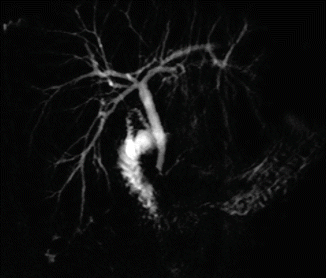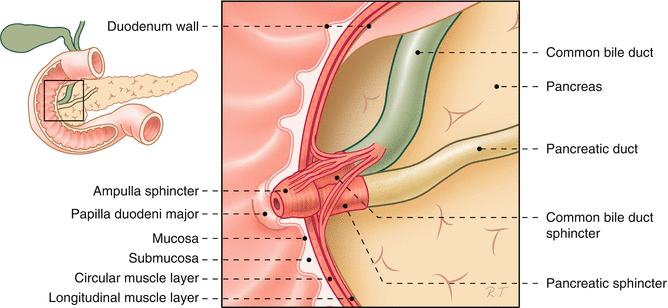, André Smout1 and Jan Tack2
(1)
Gastroenterology and Hepatology, Academic Medical Centre, Amsterdam, The Netherlands
(2)
Gastroenterology and Hepatology, UZ Leuven, Leuven, Belgium
9.1 Introduction
The bile produced in the liver is transported to the duodenum through the bile ducts. Bile mixes with the food bolus in the duodenum and facilitates digestion and absorption of certain nutrients. The liver produces bile at a constant volume, while bile is only required after a meal. Therefore, a storage system is present, which consists of the gallbladder. Whether bile is transported to the duodenum or the gallbladder is controlled in an elegant way, the volume of bile transported to the duodenum is dependent of the production in the liver, the contents and contraction of the gallbladder, and the contraction of the sphincter of Oddi. The bile ducts itself do not play a role in the regulation of bile transport as there is no peristalsis in these ducts.
9.2 Anatomy
Bile that is produced in the liver is released in the small bile ducts. These small bile ducts merge with other bile ducts and eventually end in the left or right hepatic duct and exit the liver (Fig. 9.1).


Fig. 9.1
Magnetic resonance cholangiopancreatography (MRCP) visualizes bile ducts and pancreatic duct
The right and left hepatic duct merges at the level of the liver hilum and together form the common hepatic duct. Further distally the cystic duct branches off and runs to the gallbladder. The hepatic duct is called common bile duct from that point on. In the last few centimeters, the common bile duct runs through the pancreas and merges with the pancreatic duct. The point where the common bile duct and pancreatic duct merge and open in the duodenum is called papilla of Vater or major duodenal papilla (Fig. 9.2).


Fig. 9.2
Anatomy of the sphincter of Oddi (Published with kind permission of © Rogier Trompert Medical Art 2015)
The sphincter of Oddi surrounds the most distal part of the common bile duct and pancreatic duct and controls the outflow of bile and pancreatic juices. The sphincter of Oddi consists of circular and longitudinal muscle layers, and the largest part of the sphincter is located within the duodenal wall.
9.3 Bile
The liver produces approximately 1 l bile every day. In fasting conditions the bile flows to the gallbladder, where it is stored until the next meal. When nutrients and fat in particular reach the duodenum, the hormone cholecystokinin (CCK) is released. This hormone stimulates hepatic bile production and promotes contractions of the gallbladder, which results in emptying of the gallbladder and flow of bile through the bile ducts into the duodenum. Bile is a mixture of bile salts, cholesterol, phospholipids, bile pigments, and water. Bile salts together with fat and fat-soluble contents from the foods form micelles that make the fat and fat-soluble contents soluble in water and allow absorption in the intestine. In case bile does not reach the bowel, for example, because of an obstruction of the bile ducts by a stone or tumor, much less fat absorption will take place. An absolute shortage of bile can occur after prolonged percutaneous drainage of the bile ducts.
The vast majority of bile produced in the bowel is absorbed again in the terminal ileum, and this is called the enterohepatic cycle. A patient can also develop a shortage of bile when a large part of ileum is missing, for example, after a large resection and reuptake of bile is not possible anymore.
9.4 Gallbladder
The main function of the gallbladder is the storage of bile. Because the gallbladder also absorbs water from the bile, concentration of the bile takes place. Sometimes the gallbladder has been surgically removed, usually because of problems related to bile stones. This situation however does not result in problems in fat digestion and absorption.
The contractions of the gallbladder are related to its function. The muscles in the gallbladder wall contract, causing the bile to get squeezed out. The duration and force of the contractions are dependent on the concentration of fat in the ingested meal. High-fat meals require a lot of bile and result in the strongest gallbladder wall contractions.
In fasting conditions the migrating motor complex (MMC) controls motility of the small bowel but also the gallbladder. A 90-min cycle exists of motor quiescence (phase I), increasing motor activity (phase II) and a short period of strong contractions (phase III). In phase I the muscles of the gallbladder wall are relaxed and the pressure in the gallbladder is low. Most bile that is produced in the liver flows into the gallbladder, and only a small amount flows through the bile ducts into the duodenum. When the bowels enter phase III, strong contractions of the gallbladder wall start causing bile to flow out of the gallbladder. At the end of phase III, the gallbladder relaxes again. Bile thus contributes chemical cleansing to the mechanical cleaning provided by the MMC.
Only gold members can continue reading. Log In or Register to continue
Stay updated, free articles. Join our Telegram channel

Full access? Get Clinical Tree








